By Eric Davison
The entry list of racing cars for the 1948-1950 events at Watkins Glen was a mixed lot and most were cars produced before WW2. One of the few new cars and arguably one of the most attractive was the Farago Fiat.
Paul Farago was an Italian from Calabria, Italy who immigrated to Detroit with his family in 1930. Paul’s father operated a bus line and Paul was a skilled mechanic by the time the family arrived in Detroit. He quickly established himself as an expert on foreign car repairs as well as a race car driver on local Michigan dirt tracks.
When WW2 broke out Farago served in the Army Air Corps. When the war ended he established Farago Auto Service at 18725 John R. Street between Detroit’s Six and Seven Mile Roads. His business flourished as the private garages of Detroit and its suburbs spilled out all the wonderful cars that had been put on blocks for ‘the duration.’
Farago was also a charter member of the Detroit Region of the Sports Car Club of America. The Region had been formed when Bill Woods and his brother Jack placed a classified ad in a Detroit newspaper. The Woods brothers were sports car enthusiasts and were the owners of Woods’ Motors on Detroit’s east side. They sold MGs, Hillmans and other miscellaneous imports.
The classified ad invited any-and-all Detroit area sports car enthusiasts to meet at Little Harry’s, a Jefferson Avenue restaurant owned by yet another enthusiast, Dick Haynes. The original bunch of 18 to 20 including, Farago formed the nucleus of the new Detroit Region.
While the official meetings were held at Little Harry’s, the spiritual meetings were held at Farago’s garage on John R. Street on Saturday mornings. Someone would bring coffee and someone else would show up with donuts and Paul would be in the middle of it all explaining what he was doing to a Lagonda, a BMW, a Cisitalia or anything else of interest.
With his business growing and some money coming in Paul returned to Italy for a visit to renew old friendships and to see what the Italian sports car industry was turning out. He hoped to buy something that would be suitable for racing and for the street. While he found nothing that he could either afford or that was suitable he did note that the 1100cc Fiat engine was at the heart of a variety of marvelous light weight sports racing cars, Stanguellini, Bandini, Siata, and Cisitalia to name a few.
For Farago the decision was simple, he would build his own sports car. He located a Fiat 1100 sedan in nearby Ypsilanti, Michigan that had been purchased by the Kaiser- Frazer Corporation as an evaluation and research vehicle. It was quickly purchased and transported to the shop where it was stripped to its essentials. For the next 10 months Farago and his crew cut, formed, hammered and welded until a beautiful little barchetta was ready to roll. While there was surely no computer to aid in the design, there was no drafting board either. The car was literally sketched out in chalk on the walls and floor of the garage.
The Farago Fiat was a hit in the Motor City and the local newspapers as well as the few national car magazines gave it major coverage. Paul had offers to build more and other offers to support a manufacturing operation for the car, but was not interested and the one he built was the one and only.
Farago’s intent for the car was to race it and he entered in the Queen Catherine Cup Race for cars up to 1500 cc at Watkins Glen in the fall of 1950. The car had no top and with weight saving in mind, there were no doors. Nevertheless, Paul and his fiancé Helen Klopsic stowed what small bags they had in an area behind the seat and set off for Watkins Glen. Because it had no doors, entry into the cockpit was hard to accomplish for a woman wearing skirts. Helen, a former model, had great legs and every time it was apparent that Paul and Helen were getting ready to depart a crowd of their friends would gather to whistle in appreciation when Helen swung her legs over and into the cockpit. Even the press was there to record the event.
At the Glen, the car was entered in Class G and that put him in direct competition with a couple of Cisitalias, but with a weight of 1640 pounds and an engine that would rev to 8500 rpm, the Farago Fiat had a top speed of 113 mph. Paul easily won his class. As an after thought he entered the car in the annual concours ‘d elegance where it also won a blue ribbon. The first outing was an unqualified success.
Farago’s John R. location was just a short hop to the Chrysler Corporation headquarters in Highland park Michigan and soon Farago Auto Service was full of Chrysler engineers and designers including Virgil Exner, Chrysler’s head of styling. Farago and Exner became good friends and when Chrysler was negotiating with Ghia for the creation of the Ghia/Chrysler show cars, Paul became the interpreter. Farago also became friends with Giovanni Savonuzzi, first at Ghia and later when Savonuzzi moved to Highland Park to work with the Chrysler Turbine project.
In or around 1954, Exner became very interested in the Ghia/Savonuzzi Fiat Supersonica, and encouraged Farago to considering importing the car which was based on the Fiat Otto Vu. Farago bought the example shown at the Paris Auto show and brought it to Detroit where it was garaged by a Greek by the name of Paul Lazaros. When Farago went to live in Turin in 1956, Lazaros bought the Fiat from Farago. Lazaros kept the car hidden away for some 55 years before selling it at the Gooding Auction in Phoenix this past winter. The sale price was around $1,700,000.
Paul’s work with Ghia led to a relationship with Luigi Segre, the head of Ghia resulting in Paul Farago becoming the US representative for Ghia. That relationship lasted for many years and some wonderful examples of classic styling appeared on various Chrysler chassis. Farago was involved with the Crown Imperial series of 25 luxury Chrysler Imperials built in between 1956 and 1957. With his ability to speak both Italian and English fluently, Farago’s job in Turin was to oversee the construction of the wooden framework and the manufacturing jigs.
Another Ghia project was the Dodge Firearrow, which attracted the attention of Gene Casaroll. Casaroll, creator and owner of Auto Shippers, Inc. and a serious car guy had, in the 1940s been sponsor of Champ cars that ran nationwide including the Indy 500.
Chrysler agreed to release the design and Farago and Casaroll re engineered the car and began production of the Dual Ghia, the car that was the favored vehicle of Sinatra’s ‘rat pack.’ Entertainment columnist Dorothy Kilgallen described the Rolls Royce as the car of choice for those celebrities who were not able to obtain a Dual Ghia.
With all his new and expanded activities, the beautiful little Farago Fiat barchetta was more-or-less abandoned and the garage on John R. was closed. Paul eventually sold the car. He really didn’t think too much about it. He built it, he had fun with it and now it was just a great memory and not something to lose any sleep over. Sold it to whom? “Some guy in Florida!” And that is all he could remember when I asked him the question in 1995. It would be nice to think that someone somewhere has the beautiful little masterpiece under wraps.
It would be painful to think that it lies rusting in a scrap heap somewhere. Or, that it is running around with a Chevy V8 stuffed into it. Perhaps VeloceToday readers can help find the missing Fiat Farago.
Paul Farago died at 85 in 1997 but the lore of his beautiful Fiat lives with those who saw it as just a sketch on the garage floor and saw it in action.
Notes
Author Eric Davison attended the first Watkins Glen road races with his father. He captured the early races on color film, many of which were published in Philippe Defechereux’s book, “Watkins Glen, 1948-1952.”
For more information about the Chrysler Turbine years and the amazing career of Giovanni Savonuzzi, see “Savonuzzi, The Designer“.
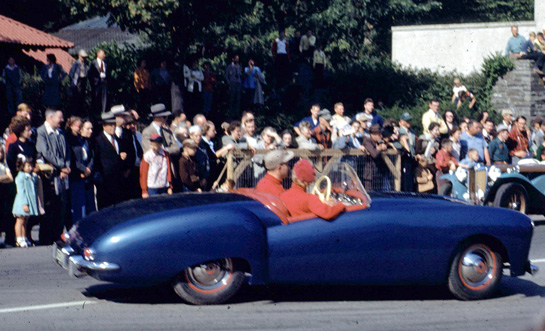
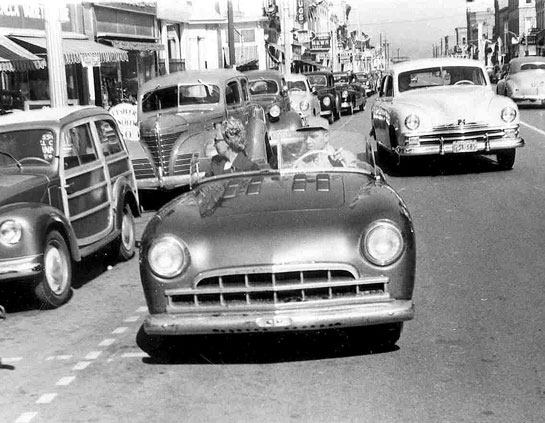
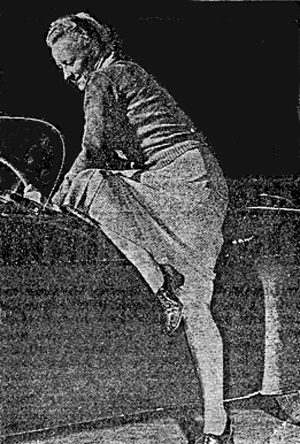
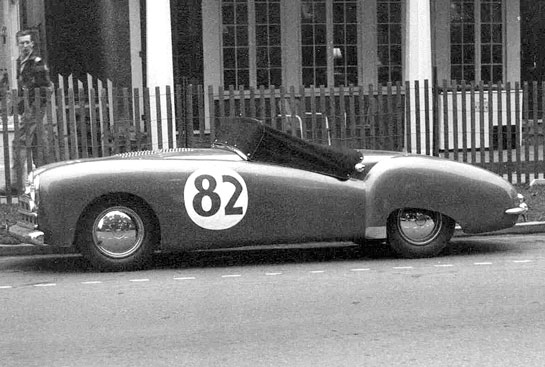
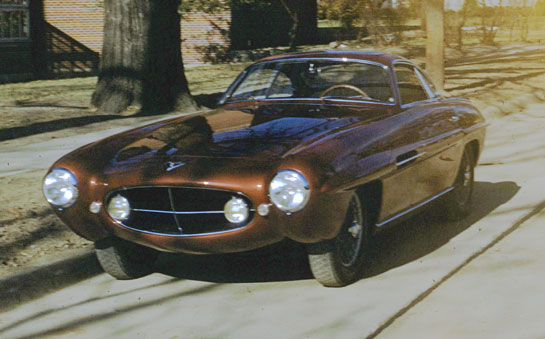

Pete — A beautifully-written, wonderfully-illustrated piece combining the early sports car scene and the Detroit car culture. Congratulations to Eric Davison on a great piece of work. — Carl Goodwin
Great article by Eric. It’s great to bring up the past with first hand knowledge. Paul was a legend and Eric brought him back.
I am Paul Farago’s nephew and he was also my best friend and the best man at my wedding. I have been trying to find the Faragao Fiat Special for the past 40 years to no avail. I have two other of the prototype cars that Paul
designed and engineered and would love to have the Farago Fiat Special. My uncle drove my mother home from the hospital with me in her arms in that car after I was born because my dad could not take more time off work from Fisher Body! I thank Eric for writing and publishing this story. It is mostly correct. But, not completely. My uncle was a very humble man and never asked for any credit fir his design and engineering achievements. However, as of recently more and more people are coming out to give him the credit he deserved in life. Thanks again Eric! By the way way the engine that my uncle had modified forth Fiat Farago special wad tested on the Chrysler Dyno and was making over 100 horsepower per litre which was quite an accomplishment for 1948.
A great story by my old advertising amigo, and I feel guilty that I was in Detroit when all this was going on but didn’t know about it because I was over on the West side, not nearly as Continental I guess as the East side. I know now that there was a “foreign car underground” in Detroit where people in the auto industry owned many interesting cars but that was the era when , if you were a GM guy, you did not drive a non GM car to work or you’d be fingered as a traitor so wisely they only brought out the toys on weekends. Misc. comments: The Supersonic body was used on other chassis. One website I found claims that not only an Alfa got the body but three XK120s, and an Aston Martin (see this website for pictures http://www.supercars.net/cars/3819.html
and also one sits on a 427 Cobra that kicks around the UK and is occasionally tested by a writer who is always scared ___less. http://www.flickr.com/photos/45676495@N05/5143619496/
I loved this article, having grown up a gearhead in Detroit while a sucker for Italian cars. I even got married the first time at Little Harry’s, with had no idea until now of its interesting status as the early meeting place of the Detroit Chapter SCCA. I always learn something new from Veloce Today!
WOW – brings back memories of going to the Detroit Auto Shows in the 1950s. Great Job!
I love his mini version of the classic ’48 Caddy grille. Great story.
Unlike the Davisons, Harry Constant and others, I missed the golden age of sports cars in Detroit. When I arrived there in the late 70’s, to write television commercials for Chrysler and join Detroit Region SCCA, one of the few vestiges of the era was David E. Davis, who used to pick up the phone at Tom Payne’s dealership in Ypsilanti and announce “Funny Little Cars!” In the mid-80’s, commercial photographer Jerry Farber had a Fiat Supersonica. It was in his studio, along with a triple-cockpit Gar Wood runabout. Thanks again for bringing this fine article to us. — Carl Goodwin